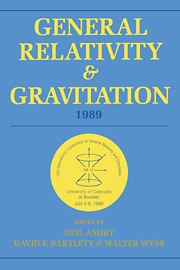 General Relativity and Gravitation, 1989
General Relativity and Gravitation, 1989 Book contents
- Frontmatter
- Contents
- Preface
- Conference committees
- Part A Classical relativity and gravitation theory
- WORKSHOPS
- Part B Relativistic astrophysics, early universe, and classical cosmology
- WORKSHOPS
- Part C Experimental gravitation and gravitational wave detection
- WORKSHOPS
- Part D Quantum gravity, superstrings, quantum cosmology
- 14 Self-duality, quantum gravity, Wilson loops and all that
- 15 Progress in quantum cosmology
- 16 String theory as a quantum theory of gravity
- WORKSHOPS
- Part E Overviews-past, present, and future
15 - Progress in quantum cosmology
Published online by Cambridge University Press: 05 March 2012
- Frontmatter
- Contents
- Preface
- Conference committees
- Part A Classical relativity and gravitation theory
- WORKSHOPS
- Part B Relativistic astrophysics, early universe, and classical cosmology
- WORKSHOPS
- Part C Experimental gravitation and gravitational wave detection
- WORKSHOPS
- Part D Quantum gravity, superstrings, quantum cosmology
- 14 Self-duality, quantum gravity, Wilson loops and all that
- 15 Progress in quantum cosmology
- 16 String theory as a quantum theory of gravity
- WORKSHOPS
- Part E Overviews-past, present, and future
Summary
The aims of quantum cosmology
Our observations of the world give us specific facts. Here, there is a galaxy; there, there is none. Today, there is a supernova explosion; yesterday, there was a star. Here, there are fission fragments; before, there was a uranium nucleus. The task of physics is to bring order to this great mass of facts which constitutes our experience. In the language of complexity theory, the task is to compress the message which describes these facts into a shorter form — to compress it, in particular, to a form where the message consists of just a few observed facts together with simple universal laws of nature from which the rest can be deduced.
In the past, physics, for the most part, has concentrated on finding dynamical laws which correlate facts at different times. Such laws predict later evolution given observed initial conditions. However, there is no logical reason why we could not look for laws which correlate facts at the same time. Such laws would be, in effect, laws of initial conditions.
I believe it was the limited nature of our observations which led to our focus on dynamical laws. Now, however, in cosmology, in the observations of the early universe and even on familiar scales, it is possible to discern regularities of the world which may find a compressed expression in a simple, testable, theory of the initial conditions of the universe as a whole.
- Type
- Chapter
- Information
- General Relativity and Gravitation, 1989Proceedings of the 12th International Conference on General Relativity and Gravitation, pp. 391 - 418Publisher: Cambridge University PressPrint publication year: 1990


